Mountain bike flow trails, aerial adventure parks, zip lines, mountain coasters, and more have helped make non-winter months profitable.
The next step in the evolution of summer is to craft a comprehensive and curated mountain experience, one that establishes a unique destination in a competitive marketplace. The aim is to expand demographic reach, increase spend, lengthen visit times, and encourage repeat visitation. Enter: Summer Ops 2.0.
If you haven’t yet began summer operations at your mountain, fear not! Summer Ops 2.0 applies to those who who are just now planning to enter the year-round game as much as it does those who already have summer “stuff.”
What characterizes Summer Ops 2.0? Comfortable places to play, eat, relax in the shade, enjoy water. Edutainment, where interpretive signage and knowledgeable guides tell the local story. Friendly and entertaining staff. And lots of Instagram moments.
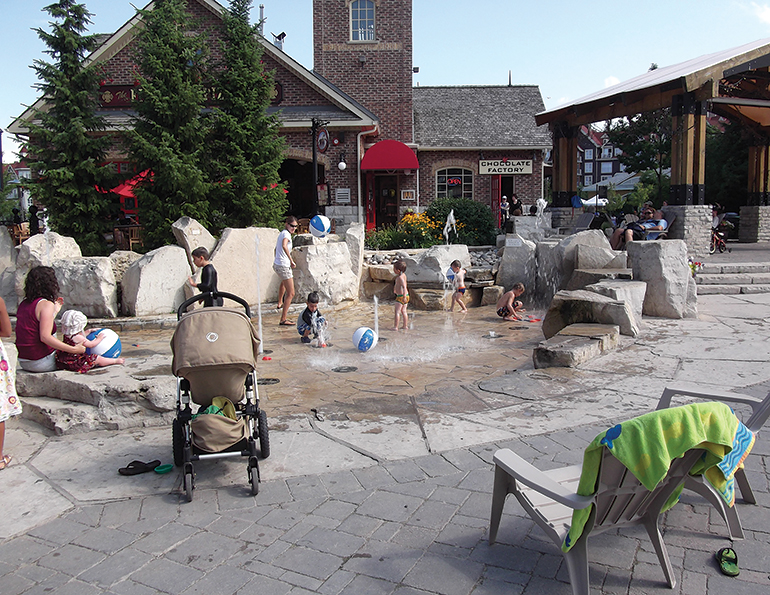 A splash pad at Blue Mountain, Ontario, is the focal point of a courtyard and encourages families to linger, eat, drink, and spend.
A splash pad at Blue Mountain, Ontario, is the focal point of a courtyard and encourages families to linger, eat, drink, and spend.
THE EVOLUTION OF SUMMER OPS
The industry has seen significant change in four-season operations since the original mix of ski-golf-water—and experts-only mountain biking, for that matter—was the norm. The past 20 years has been marked by a few key shifts that have led to the year-round businesses of today.
Shift 1: Throwing spaghetti at the wall. “Let’s see if this sticks (or falls flat).” The (often unsuccessful) trial and error phase of expanding summer operations.
Shift 2: The European invasion. “We need some of this fun summer stuff!” Early adopters added mountain-oriented attractions seen in the Alps.
Shift 3: Evolving the offering. “We need more stuff to keep folks here longer and spending more, have something for young kids, broaden the audience…” The deepening of the summer market.
Which leads us to the mature marketplace of current summer operation, where everyone has “stuff.” How can a resort offer a unique experience in this marketplace? Differentiation, the basis of Summer Ops 2.0, is the key.
 Steamboat, Colo., daylighted an underground stream in its base area. It’s now a wildly popular element of the resort’s summer scene.
Steamboat, Colo., daylighted an underground stream in its base area. It’s now a wildly popular element of the resort’s summer scene.
DIFFERENTIATION
This transition is the result of experience gained over the past 20 years. Now, it’s time to bring it all together.
Think:
• brand-specific theming
• comfortable places to play, eat, relax in the shade, enjoy water
• location-specific programming—creating unique experiences using your activities.
CREATING A BRAND-SPECIFIC EXPERIENCE
When we talk about brand, we’re not talking about logos, signage, gimmicks, interior design, etc. Brand is that almost indefinable quality that works on an emotional—not just intellectual—level to create a true connection with a guest. It’s what makes guests want to return to your place over others, even if they don’t really know why—they just know they like it. This is not achieved through a transactional experience.
Brands are about people, so it’s important to understand what people expect or want out of their experience at your resort. Defining your brand isn’t just about who you are and what you have to offer. You also need to understand consumer behavior and the kind of consumer you attract, and want to attract.
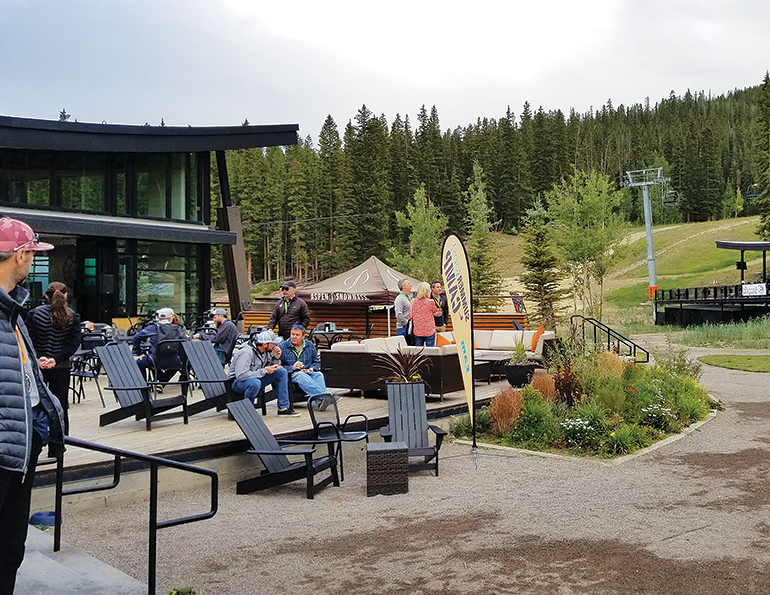 Elk Camp at Snowmass, Colo.—home of the 2018 SAM Summer Ops Camp—is an inviting space surrounded by activities.
Elk Camp at Snowmass, Colo.—home of the 2018 SAM Summer Ops Camp—is an inviting space surrounded by activities.
Having a strong brand is integral to creating a memorable experience. It differentiates your resort from the others, keeps guests coming back again and again, and builds loyalty—and recommendations.
Communicating your brand begins with your marketing materials. This is where you “paint the picture” of an experience at your resort. That visible brand presence is continued at the resort through brand-specific theming of your buildings, landscape, guest service facilities, and through the type and complexion of programs and events you host. This is how you deliver on the brand promise.
CASE STUDY: SNOWMASS LOST FOREST
The Aspen Snowmass transition to Summer Ops 2.0 is a good example of realizing your brand. Granted, Aspen Skiing Company has resources at its disposal that most other resort companies don’t have. But you don’t need money to develop and maintain a consistent brand. What you need is a clear plan.
So let’s look at Aspen’s plan. It has delivered brand-specific experiences for many years, and has continued to grow its operations, reach, and reputation, all through the lens of its brand values, positioning, and promise:
Brand description and positioning
• The Aspen Idea: renew, nurture, and enrich the mind, body, and spirit
• The Power of Four: present four unique and extraordinary alpine experiences
• Promote a sustainable natural environment, and a healthy and authentic built environment.
Brand promise
• Provide the most rewarding mountain experience possible.
• Deliver exemplary hospitality and superior guest service and amenities.
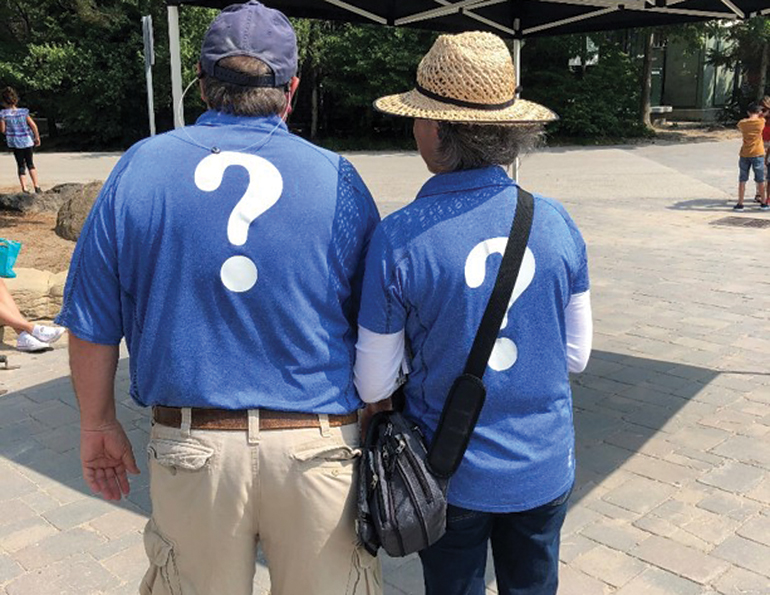
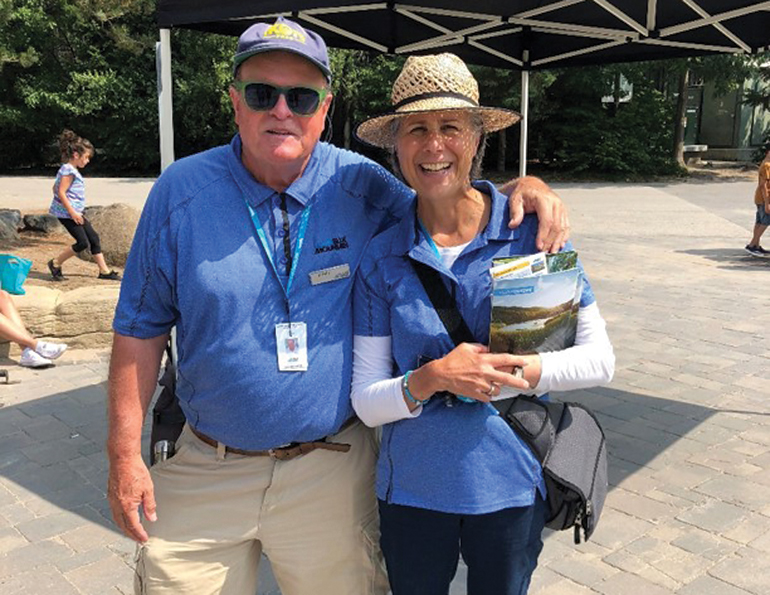 An important element to Summer Ops 2.0 is incorporating friendly, knowledgable staff to the resort experience to help reinforce the brand.
An important element to Summer Ops 2.0 is incorporating friendly, knowledgable staff to the resort experience to help reinforce the brand.
The most recent example of brand realization at Snowmass is the recently completed Lost Forest at Elk Camp, home of the 2018 SAM Summer Ops Camp this past September (see “Finding Lost Forest,” May 2018).
Lost Forest’s major installations are a mountain coaster, aerial adventure course, zip line canopy tour, and a climbing wall. A high quality mix, but none unique to summer ops at a mountain resort. So what makes it Aspen?
Aspen determined its major branding themes for these facilities early on: a sense of discovery, a celebration of the natural environment, a focus on making the activities feel integrated and artful. The last of these is a nod to Aspen Snowmass’s history of working with artists to bring art onto the mountain, so these new activities and structures share the same spirit.
These core themes led to a design direction that highlights a series of “follies”—playful structures, integrated into their surroundings, with strong design concepts, and a direct relationship to the spirit of other on-mountain buildings, including the Elk Camp Restaurant and gondola building.
MAKING EACH THEIR OWN
Branding goes way beyond the buildings, of course. Each attraction reflects the Aspen brand.
The Breathtaker Alpine Coaster, by Wiegand, was sited to weave through a rather dense patch of forest. Minimal trees were removed along the route to maintain a sense of flying through the trees, and so that the coaster is largely invisible to skiers and riders in winter. The coaster station shares the same roofline and palette of natural materials as the nearby Elk Camp restaurant.
The Treeline Trial Challenge Course and the Canopy Run Zipline Course—both from Bonsai Design—were sited with equal care. The challenge course is barely noticeable when landing at the top of the gondola, tucked just beyond the edge of the woods. And the zip line tour weaves high through the trees, ending halfway down the mountain.
At the midpoint of the canopy tour, tucked away in a particularly dense patch of forest, is a small emergency shelter. This aligns with the concepts of discovery and integration into the forest. Clad in weathering steel, the simple hut will blend into the surrounding trees and become a secret destination in the forest for skiers, hikers, and bikers to happen upon.
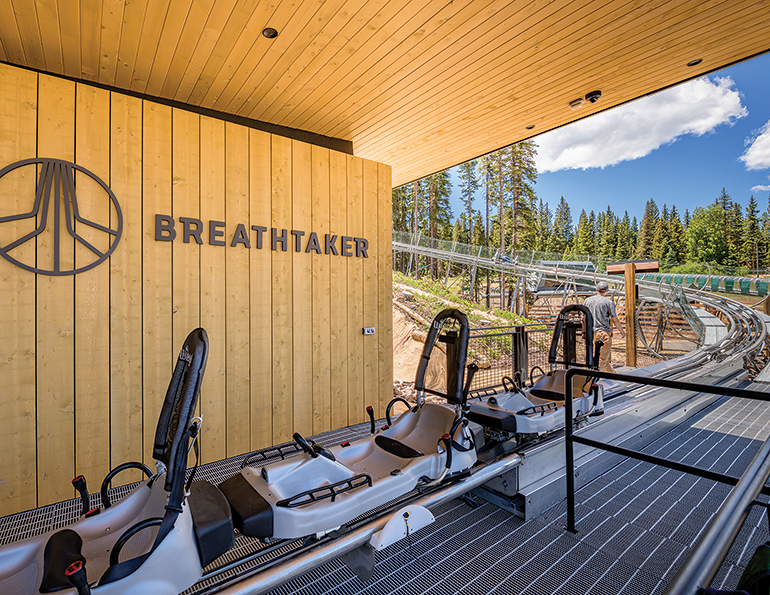 Lost Forest branding: coaster station echoes Elk Camp.
Lost Forest branding: coaster station echoes Elk Camp.
An artful tower. The Canopy Run tour ends at a 90-foot-tall freestanding tower with a final rappel down to the forest floor. Building a rather tall tower on U.S. Forest Service land adjacent to a residential area would not be easily approved. So, Aspen approached the design more as a very tall piece of art, rather than a typical zip line tower.
The tower is designed to be as slender as possible, tapering to a single point of connection with the ground. The tower is clad in long cedar boards, which are attached so they can twist and warp naturally. The wood cladding is denser at the bottom, and gets sparser as it moves up, to mimic the surrounding trees.
Slider’s Cabin sits at the bottom of the tower. This 450 sq. ft. flexible space has a large sunny deck, built-in seating, a wood-burning stove, and two restrooms. It is now available for daily rentals for groups in the winter, overnight hut trips for scouts, a point of respite for hikers and bikers in the summer, and of course, as the pick-up point for the Canopy Run shuttle. It is a great example of thinking outside the box on how to create a space that can be utilized (and monetized!) throughout the year.
In summary, Lost Forest—and the Elk Camp campus as a whole—shows how great design and planning can reinforce a brand and highlight what is special about a specific experience. Buildings are expensive—even ugly ones. Creating a sense of “place” is what makes you stand out among your competition.
 Emergency shelter nestles into the forest.
Emergency shelter nestles into the forest.
SETTING THE SCENE: CREATING “PLACE”
How do our resort environments look and feel after the snow melts? Are guests encouraged to linger? Do they feel comfortable and welcomed? Are there comfortable outdoor spaces to sit, relax, and enjoy food and drink while other members of the family take part in activities?
From wayfinding to planting, water features and shade, extra attention to these design considerations goes a long way in creating a sense of place that encourages guests to stay longer and return often. (For more on this, read “Green Is the New White,” SAM July 2018.)
PROGRAMMING: “CURATING” THE EXPERIENCE
Summer Ops 2.0 involves more than just adding a bunch of activities. It means packaging your “stuff” and staff to create place-specific and brand-specific guided experiences. The benefits of this are many:
• increased utilization of activities
• advanced booking leads to more predictable business
• extends the time spent at the resort, perhaps turning a day trip into an overnight
• value-added “curated” experiences translate into higher price points
• opportunities for building customer loyalty, i.e., repeat programs for locals
• creates endless Instagram moments (formerly called “memories”)
 Slider’s Cabin and Canopy Run tower build consistency.
Slider’s Cabin and Canopy Run tower build consistency.
At Snowmass, developing a series of programmed activities and events was integral to the development of Lost Forest. Some examples:
Evening Programming. Two happenings:
• Ullr Nights. Friday nights during the winter season, the Lost Forest area becomes the venue for a lively celebration of winter. It almost always sells out; tubing and the mountain coaster are additional paid activities.
• Farm to Table Tuesdays. This popular culinary experience at Elk Camp—held Tuesday nights in July and August—features locally sourced food and drink. It is expected to produce even more revenue next summer, with all Lost Forest activities available for a fee.
Camp Aspen Snowmass. This kid’s day camp utilizes Lost Forest activities three days a week, creating a unique product in the crowded kid’s camp market of the Aspen valley.
Lost Forest Explorers. A group guided Lost Forest experience, available for kids ages 8 to 17. Parents can drop kids off at the mountain or use the shuttle pickup in Aspen. Important note: Make it easy for parents!
Private Groups. Customized, small to medium group experiences can include F&B in addition to access to some or all of the Lost Forest activities.
 Tower design artfully mimics trees in surrounding forest.
Tower design artfully mimics trees in surrounding forest.
THE EVOLUTION CONTINUES
Expanding demographic reach, increasing spend, lengthening stays, repeat visitation, and successful differentiation within the competitive marketplace. Sound good?
Think beyond the “stuff.” Harness the creativity of your management team, instructors, and staff, and set the stage for unique experiences.
This article is based on a presentation at the 2018 SAM Summer Ops Camp.






